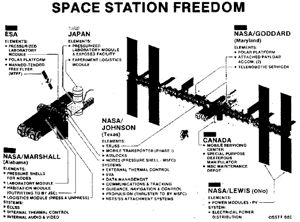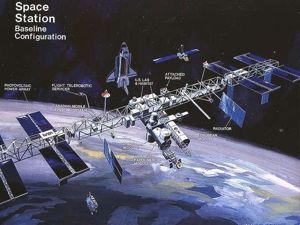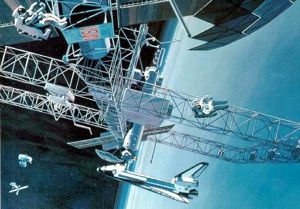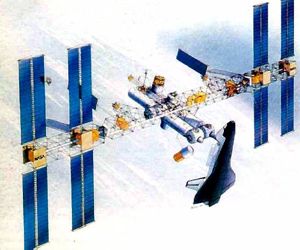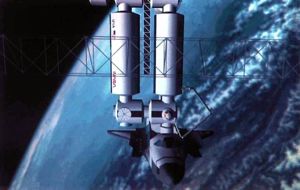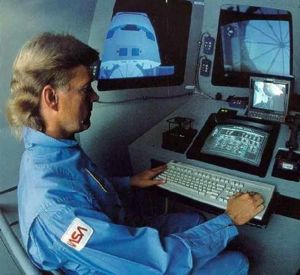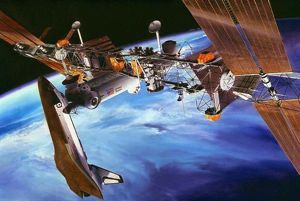
Home - Search - Browse - Alphabetic Index: 0- 1- 2- 3- 4- 5- 6- 7- 8- 9
A- B- C- D- E- F- G- H- I- J- K- L- M- N- O- P- Q- R- S- T- U- V- W- X- Y- Z
Space Station Freedom
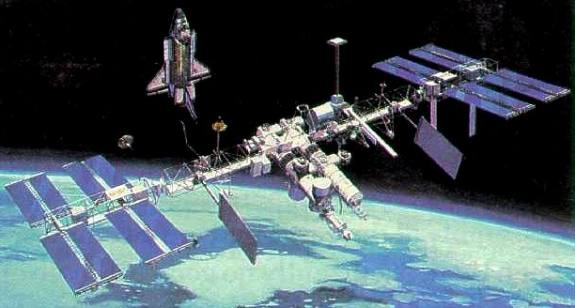
Freedom 1987
Credit: NASA via Marcus Lindroos
Status: Design 1988.
However, NASA and Reagan Administration officials reached a compromise in March 1987 which allowed the agency to proceed with a cheaper $12.2-billion Phase One Station. This design initially omitted the $3.4-billion 'Dual Keel' structure and half of the power generators. The new Space Station configuration was named 'Freedom' by Reagan in June 1988.
NASA's first detailed cost assessment in February 1987 revealed the 'Dual Keel' Space Station would cost at least $14.5 billion in 1984 dollars, or $21 billion in current-year dollars. This caused a political uproar in Congress, where many politicians had started to express doubt about the project. However, NASA and Reagan Administration officials reached a compromise in March 1987 which allowed the agency to proceed with a cheaper $12.2-billion Phase One Station (1984 dollars; $17.7B in current-year dollars) that could be completed after 10 or 11 Shuttle assembly flights. Annual funding levels would be: $767 million in FY 1988, $1.4 billion in FY 1989 and 1990, $2.3 billion for the next three years and $1.4 billion in FY 1994. This design initially omitted the $3.4-billion 'Dual Keel' structure and half of the power generators. The new Space Station configuration was named 'Freedom' by Reagan in June 1988.
NASA tried to reduce the number of Shuttle assembly flights by making several modifications. The first launch would now take place in March 1994, the Station would be permanently manned from April 1995 onwards and be completed in March 1997 after 17 flights. Congress disliked the 6-9 month delay and briefly demanded that the schedule be accelerated.
Space Station work distribution following the 1987 redesign. As always, considerable political filling and sanding was required since the Lewis and Goddard Spaceflight Center-led Work Packages mostly involved 'Dual Keel' elements that now were postponed indefinitely.
The American co-orbiting space platform was deleted in 1987 but the polar platform was retained. The European Space Agency was also going to contribute a second polar platform plus a man-tended free flying platform (MTFF) in the same orbit as the main Space Station complex.
Scientists disliked its reduced capabilities, e.g. the number of attached payloads had been reduced to two from the 'Dual Keel's' five berths. Other common criticisms involved the Station's increased cost and delayed schedule, and its impact/reliance on the Space Shuttle. Many scientists wanted a smaller Skylab-type single-module facility that could be launched earlier on a new heavy-lift rocket. Users also criticized NASA for not spending enough money on Space Station experiments.
Originally, Space Station 'Freedom' would only have carried two 37.5 kW solar arrays during Phase One. However, Congress quickly insisted on adding two more arrays to generate sufficient power for scientific users. The Space Station program was plagued by conflicts during the entire 1984-87 definition phase. NASA and ESA were unable to reach agreement on Europe's role in the program. ESA refused to accept the congressional requirement that Europe be banned from using its Columbus module for materials research. The Europeans also regarded a 15% 'you get what you pay for' operational return as insufficient and instead wanted a consensus-based partnership arrangement. In April 1987, the Department of Defense briefly demanded to have full access to the Station for military research, despite strong objections from NASA and the international partners. The lack of a unified federal policy on the project really began to make itself felt. Besides the expected furor from the international partners, the DoD position sparked a shouting match between Defense Secretary Caspar Weinberger and powerful members of Congress that extended right up to the final Fiscal 1988 budget authorization in July 1987.
Technically, the $3-4 billion Phase Two 'Dual Keel' spacecraft assembly and servicing facility was still in the 1987 baseline. But there was no funding commitment and NASA officials privately expressed doubt it would ever be built. Advocates of manned planetary exploration (e.g. the Planetary Society) were upset when NASA removed the Station's large spacecraft assembly and checkout capability. The expanded 'Dual Keel' Space Station 'Freedom' made a final comeback in 1989 when President Bush proposed a Moon base by 2001-2005 and missions to Mars by 2018. NASA estimated the 'Dual Keel' lunar spacecraft support facility, additional power generators, crew modules for 14-16 astronauts etc. would cost at least $1 billion.
Despite all the problems, the Space Station plan was approved (with reservations) by a National Research Council panel in September 1987, finally clearing the way for NASA to award Phase C/D development contracts in December. The combined value of all four Phase C/D Work Packages was over $5 billion. The connecting node modules were expanded in late 1986 and filled with equipment to reduce the need for mounting exterior components. This would hopefully reduce the number of required EVA 'spacewalks' for assembly and maintenance.
Life scientists complained that the other major Station user (materials science) received too many research opportunities while deploring the lack of a variable-gravity centrifuge, animal holding facility and a dedicated life sciences lab. By 1986-87 it was becoming increasingly obvious that there would be no major market for commercial space manufacturing on the Space Station. When President Reagan approved the project in 1984, some analysts forecasted the space manufacturing business would be worth up to $20 billion per year in 2000. The projections turned out to be overly optimistic, in part because the 1986 Challenger accident greatly increased the commercial cost of Space Shuttle missions while reducing the number of flight opportunities.
A Space Station Intergovernmental Agreement was finally signed in September 1988 allocated 97% of the US lab resources to NASA while the Canadian Space Agency would receive 3% in return for its contribution to the program. Europe and Japan would retain 51% of their own laboratory modules. The United States and Canada would receive 46% and 3%, respectively. Six Americans and two international astronauts would be permanently based on Space Station Freedom. Each crew member would serve 90 days according to the original 1987 plan. However, NASA soon increased the tour of duty to 120 days in order to reduce the number of Shuttle flights from eight to 5-6 to reduce the transportation requirement. Many observers were concerned about the Shuttle's reduced capability and questionable safety after the 1986 Challenger accident, and NASA was requested to examine unmanned heavy-lift rockets and alternative manned backup spacecraft in case the Shuttle would have to be grounded again.
Shuttle dockings, EVA astronauts 'spacewalks' and other activities outside the Station would have been supervised from workstations inside an observation cupola.
The April 1987 Space Station budget agreement did not last long. First, Congress reduced the Fiscal 1988 budget from $767 million to $525 million. Of this, only $300 million was available until June 1 1988. NASA was to receive the additional money only if it delivered a less costly 'rescoped' program. In June 1988, Senator Bill Proxmire managed to effectively suspend the program until after the 1988 elections when President Bush reaffirmed his support. The Space Station only received a $900-million Fiscal 1989 budget, 50% less than the 1987 plan had assumed and $2.5 billion less overall.
Nevertheless, NASA signed final ten-year contracts for developing the Space Station in September 1988. The project was finally moving into the hardware fabrication phase. The Space Station Freedom design was slightly modified in late 1989 after the program's Fiscal 1990 budget again was reduced -- from $2.05 billion to $1.75 billion. For example, the radiators and attitude control thrusters were simplified. NASA also briefly considered replacing the solar panels with solar thermodynamic power generators, which cost less in the long term but would have required another $50-100 million research and development investment.
By this time, repeated budget cut had forced a postponement of the first launch by a year, to March 1995. The Station would be permanently manned from June 1997 onwards and completed in February 1998. The international partners were not happy because NASA did not consult them and because their modules now would be postponed by one year. The available power to all users would also be reduced to 30 kW, down from 45 kW. A new $321-million spacesuit was also deleted although this only made it harder for astronauts to assemble and maintain the Station's external structure. The total cost had increased to $19 billion ($13 billion at 1984 rates) and NASA had to start a new Advanced Solid Rocket Motor program in 1989 to boost the Shuttle's payload carrying capability as the Station kept growing heavier and more complex.
The Space Station Freedom project finally collapsed under its own weight in 1990, when the design was found to be 23% overweight, over budget, too complicated to assemble while providing 34% too little power for its users. A NASA panel led by Bill Fisher and Charles Price then discovered that 2,282-3,276 hours of EVA 'spacewalks' would be required per year vs. NASA's goal of 500 EVA hours/year... Congress consequently demanded yet another redesign in October 1990 while requesting further cost reductions as the Fiscal 1991 budget was cut from $2.5 billion to $1.9 billion; the overall budget cut would be $6 billion over five years. NASA unveiled its new Space Station design in March 1991. The resulting new configuration was mockingly referred to as 'Space Station Fred' by the critics.
Article by Marcus Lindroos
Habitable Volume: 878.00 m3. Electric System: 68.30 average kW.
Family: Space station, USA - Space Stations. Country: USA. Launch Vehicles: Proton-K, Space Shuttle. Agency: NASA. Bibliography: 6915.
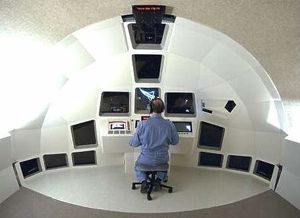 | Station Simulator Space Station Simulator 1986 Credit: NASA via Marcus Lindroos |
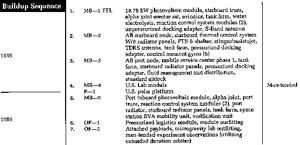 | 1987 Freedom Assy 1987: Space Station Freedom Assembly. Credit: NASA via Marcus Lindroos |
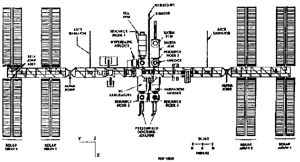 | Freedom 1987 1987: Space Station Freedom. Credit: NASA via Marcus Lindroos |
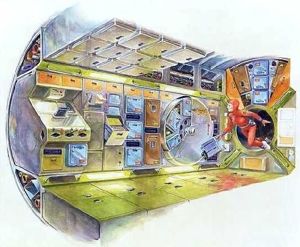 | Freedom Crew Modules Space Station Freedom Crew Modules. Life science module proposal from 1987. Credit: NASA via Marcus Lindroos |
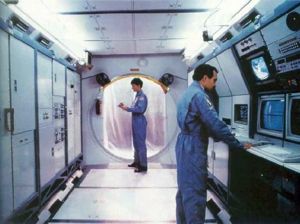 | Aboard Station 1987 Life Onboard Space Station Freedom. The US laboratory module, 1987. Credit: NASA via Marcus Lindroos |
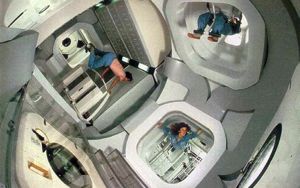 | Freedom Crew Modules Space Station Freedom Crew Modules. This photograph shows the interior of one of the four connecting node airlocks. Credit: NASA via Marcus Lindroos |
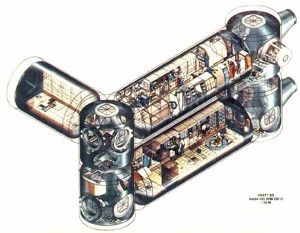 | Freedom Crew Modules Space Station Freedom Crew Modules. Boeing's winning proposal for the $750-milllion crew module Phase C/D contract. Credit: NASA via Marcus Lindroos |
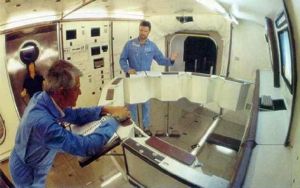 | Aboard Station 1988 Life Onboard Space Station Freedom. Off duty astronauts relaxing inside the US habitation module. The table can be folded away to save space. Credit: NASA via Marcus Lindroos |
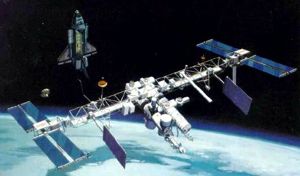 | Freedom 1987 1987: Space Station Freedom. The new Space Station configuration was named "Freedom" by Reagan in June 1988. Credit: NASA via Marcus Lindroos |
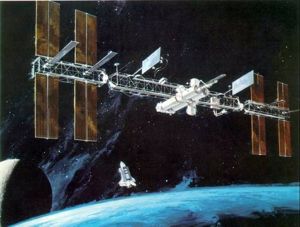 | Freedom 1989 1988-90: Problems For Space Station Freedom. Credit: NASA via Marcus Lindroos |
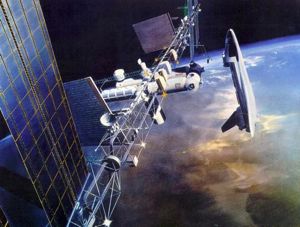 | Freedom 1990 Space Station Freedom Baseline. Credit: NASA via Marcus Lindroos |
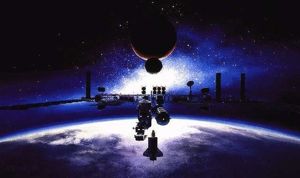 | Freedom Sunset 1993: End of Space Station Freedom. The Sun sets on the Space Station "Fred" project. Credit: NASA via Marcus Lindroos |
 | Freedom Credit: NASA via Marcus Lindroos |
 | Freedom Credit: NASA via Marcus Lindroos |
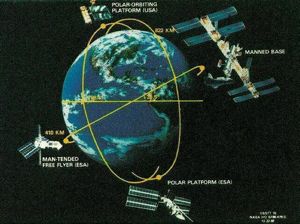 | Freedom Space Station Freedom Baseline. The American co-orbiting space platform was deleted in 1987 but the polar platform was retained. Credit: NASA via Marcus Lindroos |
1989 October - .
- Rockwell begins year-long contracted study of HL-20 - .
Nation: USA.
Spacecraft: HL-20,
Space Station Freedom.
Rockwell International (Space Systems Division) began a year-long contracted effort managed by Langley Research Center to perform an in-depth study of Personnel Logistics System design and operations with the HL-20 concept as a baseline. The spaceplane would supplement the shuttle in support of the Space Station Freedom.
1991 October - .
- Lockheed feasibility studies of HL-20 - .
Nation: USA.
Spacecraft: HL-20,
Space Station Freedom.
Lockheed Advanced Development Company began a study to determine the feasibility of developing a prototype and operational system. The study objectives were to assess technical attributes, to determine flight qualification requirements, and to develop cost and schedule estimates.
1991 December - .
- HL-20 Mock-up tests completed - .
Nation: USA.
Spacecraft: HL-20,
Space Station Freedom,
X-24A,
X-38.
NASA, North Carolina State University and North Carolina A&T University built a full-scale model of the HL-20 for human factors research on the concept. In the end, space station Freedom became the International Space Station. As the initial crew emergency rescue vehicle, the Russian Soyuz spacecraft was selected. However NASA, looking for a higher-capacity alternative and concerned about reliable availability of the Soyuz in the future, did begin development of the X-38 CERV in 1997. The X-38 was however based on the Johnson concept of parachute-assisted landing, and used the pure-USA X-24 lifting body shape....
1992 November - .
- Mir-2 joint use with ESA discussed - . Nation: Russia. Spacecraft: ESA MTFF-Derived Space Station, Mir-2, Space Station Freedom. Further financial difficulties in Russia and uncertainties with America's Freedom space station led Russia and the European Space Agency to open discussions on joint development and use of Mir-2..
1993 November - .
- International Space Station - .
Nation: Russia.
Spacecraft: ISS,
Mir-2,
Space Station Freedom.
Cost escalation of the US Space Station Freedom, and financial difficulties in Russia, led to a summer 1993 briefing of NASA by NPO Energia on Mir-2. In November 1993 Freedom, Mir-2, and the European and Japanese modules were incorporated into a single International Space Station.
Back to top of page
Home - Search - Browse - Alphabetic Index: 0- 1- 2- 3- 4- 5- 6- 7- 8- 9
A- B- C- D- E- F- G- H- I- J- K- L- M- N- O- P- Q- R- S- T- U- V- W- X- Y- Z
© 1997-2019 Mark Wade - Contact
© / Conditions for Use
